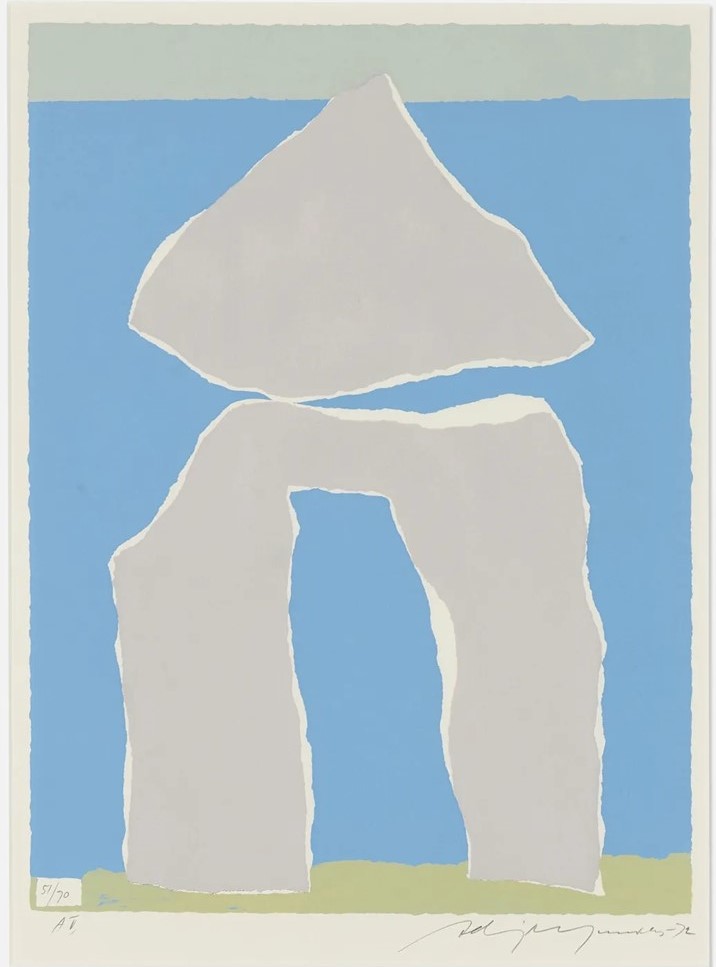
Triangle Arch (A V) by Adja Yunkers
This is a screenprint I've titled Triangle Arch but which is title A V by noted artist Adja Yunkers. It dates from 1972. It is very characteristic of his post-war style with use of bold colors and geometric shapes. Three rectangles of color, green, blue, and gray comprise the ground and imply abstracted grass, sky, and clouds. On this ground are two objects, a gray arch topped by a gray triangle. The piece evokes a closeup of monoliths in an ancient stone circle. His pieces are titled (or in this case provided with an ambiguous symbol) to imply mysticism while the images draw from archtypes and indigenous imagery as seen in tribal masks and figures or, in this case, shapes reminiscent of stone figures or gnomons. These images had significant influence on art in the post-war period by artists such as Yunkers, Adolph Gottlieb, Jean-Michel Basquiat, and others. This is a large screenprint. The image is 19.75 x 26.5 inches and is printed on a sheet 24 x 34 inches. It is pencil signed and dated lower right and titled? A V lower left. This is #24 from an edition of 70--a typical edition for Yunkers. The image is crisp with bright colors and no fading. The paper is in pristine condition. It is unframed and is a free sheet under glasine on foam core. A great example of this artist's work.
Adja Yunkers (1900-1983) Yunkers was born in Latvia, Adolf Eduard Vilhelm Junker. His artistic talents were recognized early, but documentation of his formal training is lacking. However, he followed a peripatetic path across the Western world that led him to interact with some of the most notable artists of the early 20th century. These include the Sturmgruppe (Emil Nolde, Karl Schmidt-Rottluff, and Carl Friedrich Schmidt during his time in Germany, Wassily Kandinsky, Marc Chagall, and Alexander Archipenko from a stay in Russia, and Diego Rivera in Mexico. Despite these diverse influences (or perhaps because of them) Yunkers developed a distinctive abstract style that encompassed a wide range of artistic media including painting, drawing, and murals. He is best known as a printmaker coming to attention with a woodcut series from the 1930s on the Ten Commandments. His reputation as a graphic artist was established by the mid-1930s, but really took off in the post-war period. He moved to the United States in 1947, working and teaching across the country including Barnard College and Cal-Berkeley. He founded the Rio Grande Workshop in Albuquerque and taught there for many years. He came to lithography relatively late in his career, learning the technique in New Mexico at the Tamarind Workshop. This would become his dominant medium for the rest of his career. His work is held in major collections internationally including the Hamburg Kunsthalle, the Rijksmuseum, the Bibliotheque Nationale, and the Victoria and Albert Museum. United States collections include the Smithsonian American Art Museum, the Corcoran Gallery, the Guggenheim, and the MoMA.
Price: $975
Size: 24 x 34 inches
Plate Size: 9.75 x 26.5 inches
Condition: Excellent
Medium: Serigraph
Subject: Abstract
Shipping, handling and insurance is included for purchases within the US and Canada. We ship internationally. Please contact us for shipping cost and invoice information.

